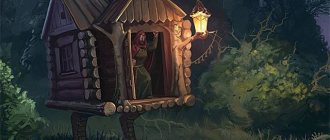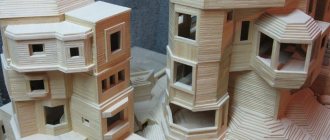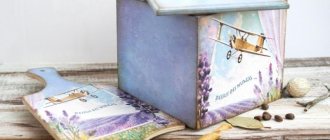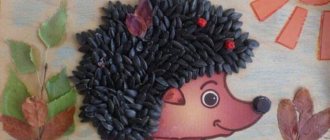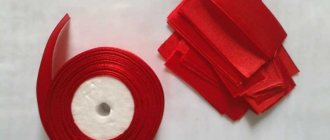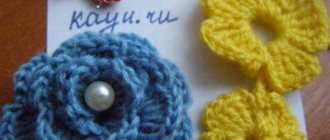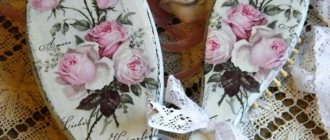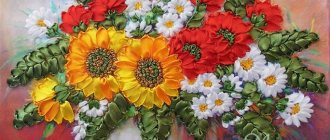General cutting rules
The key to any beautiful thing is its neatness and geometric accuracy. Just like when assembling a mosaic, patchwork requires perfectly calculated and cut pieces that, when combined, will not turn out to be incompatible.
To do this, you need to follow some cutting rules:
- To avoid deformation, change in size and color, after washing a manufactured item, the fabric you just purchased should be washed and then steamed with an iron.
- Before working with previously used pieces of fabric, they should be soaked in a solution of water and starch (it is better to do this with a spray bottle), and then ironed.
- To draw the fabric into scraps of the desired shape, you should use soap or special chalk, or, in extreme cases, a pencil with a soft lead. But under no circumstances should you draw on fabric with a pen: the ink, being absorbed into the fabric, remains there forever.
- Fabrics should be cut in the direction of the grain thread, otherwise the parts may become deformed when sewing. When working with new fabric, you need to focus on the edge.
To cut fabric into elements, you first need to make 2 templates of the desired shape from thick paper or cardboard: one with indents, the second without them. Apply each of the templates to the material one by one and trace it using the above tools.
Rug made from old T-shirts: manufacturing methods and instructions
There are several ways to make a beautiful rug from unwanted old T-shirts: on a hoop, braiding, from scraps of fabric, on a mesh, knitted, braided, crocheted. Each method will allow you to create a unique work that will decorate your home.
To begin with, you should try to make simple round rugs that start from the center, gradually increasing in diameter as the rows are knitted.
For the “weaving” technique, take a round base or a rectangle.
When the weaving is finished, the tip of the ribbon is secured with a needle and thread.
The base of the mat is a painting or plaster mesh. Cut a piece of mesh to the size of the future carpet.
Which fabric is best for the job?
Any fabric that is close to the soul of a beginning seamstress can be suitable for patchwork sewing. However, each fabric has its own characteristics and characteristics, which can subsequently affect the ease of use, and, consequently, the quality of the finished product.
Cotton fabric is considered the most popular, since its characteristics allow even novice needlewomen to work with it:
- Optimal density and weight;
- does not shrink when washed;
- when circumcised, it does not crumble or spread;
- does not change color;
- easy to stitch;
- immediately takes the desired shape, which it retains for a long time.
Due to its quality, linen also occupies the top position in the choice of material:
- Durability, wear resistance;
- hypoallergenic;
- high thermal conductivity and breathability characteristics;
- practically does not electrify, even with strong friction.
Patchwork silk products look beautiful and expensive, but they are difficult for beginners.
It is very difficult to work with the material: it is very highly electrified, any mistake made when sewing or cutting will immediately catch your eye. In addition, it is not suitable for creating things for the home (blankets, pillow covers, etc.), as it wears out very quickly and becomes unusable, losing all its luster and beauty.
Today, the trend is warm, homely looks, due to which the popularity of wool products has increased. In addition to the aesthetic function, this material also has a practical one. It’s easier to work with than silk, but you’ll have to get your hand a little used to it first, as problems often arise when stitching.
Among the advantages of this matter are:
- Maintains a neat appearance, as it does not wrinkle;
- resistant to various stains;
- absorbs excess dampness in the house, which does not affect the appearance of the material;
- elastic;
- can last for many years.
One of the advantages of patchwork is that you don’t need to choose only one type of fabric; they can be combined with each other, creating original things.
Unusual things with your own hands
Sewing from scraps of fabric is a way to create original things that will not only decorate your home interior, but will also be functional and useful. For beginners, more experienced craftsmen suggest doing the first small-sized work.
To try out different sewing styles, you need to practice making oven mitts, pillowcases for decorative pillows, cosmetic bags and bags. Below you can see detailed instructions for creating unusual things for the home from scraps.
Preparation of materials and tools
First of all, you need to choose the fabric. It is desirable that the product consist of scraps of the same type of material. Using flaps of different textures it is difficult to achieve a good result. The combined style is only suitable for sewing using the crazy and pizza techniques.
The table shows the names of the most popular materials for patchwork, as well as their properties:
Sewing from fabric scraps: tools and materials for work.
| Materials | Properties |
| Cotton | They are not prone to shedding, can be ironed, and shrink when washed in hot water. |
| Linen | Often used for substrate. They don't shrink after washing, but they wrinkle a lot. |
| Woolen | They do not wrinkle and retain their original appearance for a long time. |
| Viscose | They smooth out well, but they lose their shape due to frequent washing. |
| Synthetic | Ironing should be done carefully. The edges often crumble. They retain their shape for a long time and do not lose color. |
It is important that the material is combined in color, as well as in the theme of the drawing. The most common types of designs on fabric are: floral, children's and geometric.
What tools do you need to prepare for work:
- Sewing machine and overlocker.
- Iron or steamer.
- Measuring instruments: measuring tape, straight and triangular ruler.
- Scissors or rotary cutter.
- Tailor's pins.
To create and accurately redraw diagrams, you will need graph paper.
Beautiful patchwork bags
Bags from scraps can be sewn in any style and in different styles.
This description of the work steps is suitable for classic options:
- Make patterns for the sides, bottom and ends.
- For the backing you need to use a dense material, for example, denim.
- The flaps are sewn onto the main fabric in any order, depending on the chosen style.
- The parts are combined into a whole product.
- Fasten locks and handles and other fittings.
For beach options, you can use synthetic and cotton fabrics. For everyday options, leatherette is suitable. It is easier to care for and the bag will last longer.
Patchwork knitted rug
Knitted fabrics make soft and bright rugs. To create them, needlewomen often use the “lyapochika” technique.
An example of making a square rug in 5 colors:
- The prepared fabric is cut into shreds in the form of strips of the same size.
- As a base, you need to choose a dense material that will not slide too much on the floor.
- Markings are made using colored crayons or markers to help position the material evenly. An example of a pattern based on 80x80 cm: a circle with a diameter of 20 cm in the center, 2 rings around it 7 cm wide, a frame extending 10 cm from the edge. The space between the rings and the frame will be filled with plain shreds.
- According to this scheme, it is easier to start working from the middle than from the bottom row. Therefore, using a spiral stitch from the center, the circle is filled with stripes stitched in the middle.
- The color is changed to a contrasting one and 1 ring is made, then the color of the fabric is changed again and the 2nd ring is sewn.
- Now fill the empty space up to the frame. Here you can start sewing rows from the bottom. The color may be new or the same as the first round.
- The frame is decorated with darker fabric.
If the rug still slides on the floor, you can purchase special rubberized corners. They are glued to the back of the product, and it will no longer get confused or slide off.
Blanket made from different patches
Quilts are often made using the American quilting technique. To work, you will need cotton fabric for the base and for cutting out the flaps, as well as thin padding polyester for the backing.
Here is an example of sewing a baby blanket, size 140x90 cm:
- To make the product look more interesting, you can decorate its front side with a checkerboard pattern. It will consist of 126 square patches measuring 10x10 cm, 63 of which will be one color, and the remaining 63 will be another.
- First you need to sew the finished fabric. To simplify the task, you should cut out not squares, but strips 12 cm wide and 142 cm long (with seam allowances). You will need 9 of them. Accordingly, 4 of them are one color, 5 are another. The strips are sewn along the long edge and then cut lengthwise into strips 10 cm wide.
- All that remains is to unfold the strips so that the squares are arranged in a checkerboard pattern and reconnect the fabric into a whole canvas.
- Now they cut out the base, put padding polyester on it, and cover it with a cloth of rags on top. Sew the blanket around the edges.
- Now you need to give the product a quilted look; to do this, machine stitching is passed along all the lines dividing the squares.
- The edges of the blanket can be trimmed with braid or soft lace.
For children's blankets, it is better to use soft fabrics, such as flannel, with a children's print.
Patchwork style bedspread
Bedspreads for a bed or sofa are made according to a pattern similar to a blanket. For work, it is better to give preference to dense fabrics that are easy to wash and iron. Suitable jeans, wool jacquard, bamboo.
The flaps can be of various shapes: square, triangular or hexagonal. The main thing is to get the color pattern right. Thick fabric can be sewn without a lining, but to give the bedspread a more aesthetic appearance on both sides, cotton and viscose fabrics can be used as a backing.
The patterns are connected in any order. Products assembled from prepared blocks look beautiful. To calculate the number of blanks, you need to divide the area of the bedspread by the area of 1 flap or block. At the end of the work. The edges are processed using an overlocker or decorated with a matching color braid.
Covers for stools
These products are sewn using a variety of techniques. The most popular design styles: “pizza”, “bargello”, “American quilting”.
Universal instructions:
- The seat of the stool is measured and a pattern is made from dense fabric, which will serve as the base.
- If the stool is square, then you need to sew laces to the lining at each corner, which will secure the cover. They are tied around the legs of the stool. For round seats, it is better to make a cover with an elastic band.
- Flaps are sewn onto the lining in accordance with the chosen style. The excess is cut off and the edges are trimmed with braid.
To sew an elastic band to a round product, you will need to make a border from synthetic fabric. To do this, cut out a strip 7 to 15 cm wide and sew it to the base. A wide elastic band is secured along the edges.
Toys made from fabric scraps
Sewing from scraps of fabric allows you to create more complex products, for example, soft children's toys. Basically, they are sewn using the classical technique, since the patterns are not standard, and a large number of decorative seams or small scraps can spoil the appearance of the craft. Cotton, chintz and flannel fabrics are used for sewing.
Experienced craftsmen can stitch fuzzy and synthetic patches beautifully. Standard patterns are used as a basis for work, each part is made from a different material. For beginners, it is better to start working with flat products. These toys are called “scops owls” because they are shaped like a small pillow.
The parts for such patterns are quite large, so the entire area of the toy can be filled with small scraps. To decorate such crafts, buttons, beads, and special accessories are used: eyes and noses made of plastic.
Patchwork is not difficult to master. It is important to start with simple jobs and gradually move on to more complex ones. To create beautiful products, you can use new fabric, and also give a “second life” to old things by cutting out scraps from unwearable clothes.
Patchwork technique and its varieties
This sewing technique has a long, rich history, during which patchwork has acquired new forms and varieties, thanks to which every beginner can choose their favorite sewing patterns using step-by-step instructions and photos.
Traditional version of the patchwork technique
Things in traditional patchwork are made using pieces of fabric shaped like simple geometric shapes with regular silhouettes. In this option, you can make things both small (pillowcase, potholder) and large (blanket, rug).
A distinctive feature of classic patchwork is that the front side consists of patches , while the lining can consist of solid material.
Japanese patchwork
This version of sewing from scraps combines the traditions of the East and West. For the most part, large-sized items are made using this technique. Preference is given to silk fabrics, mostly expensive and of high quality. But to fill the arms, beginners can train on a cheaper variety of silk.
The basis of the elements, as in the traditional version, are geometric shapes:
- squares,
- rectangles,
- diamonds.
Knitted patchwork
This type of patchwork is in many ways similar to the traditional one, however, here the elements are not sewn together, but are connected using a hook.
Moreover, different materials can be used. The most common items used in this type of patchwork are women's bags and bedspreads.
Crazy patchwork
Unlike other types of patchwork, here the elements do not have clear geometrically regular shapes, rather the opposite - hence the name.
Threads in places of stitching are masked by various means: lace, ribbons, embroidery, etc. In addition, the use of beads, seed beads, buttons, and various pendants is common.
Quilt
In this technique, using machine stitching that reproduces various patterns, 2 fabrics are sewn together, between which a soft lining, for example, made of padding polyester, is placed. This type of patchwork attracts craftswomen with greater elegance.
Potholders
Patchwork potholders are practical and decorative.
Their gift sample is a pleasant surprise for loved ones. The main advantage is low thermal conductivity (Also find out how to sew oven mitts for the kitchen with your own hands).
Square potholder
To make it we need:
- cotton fabric;
- threads;
- batting;
- cotton edging.
Procedure
- Let's make a cardboard square - a template and cut it out.
- Apply it to the fabric and outline it with chalk, taking into account the seam allowances.
- Let's cut out 2 of these squares.
- Connect the squares with pins.
- We sweep them away by hand.
- We will make a loop from the braid and insert it between the squares.
- We sew the tack, leaving 5-6 cm unsewn, so that we can then turn it inside out and push the batting inside.
- We sew the unstitched area by hand.
Note! The heart-shaped patchwork tack is done in the same way, but it is better to edge it all with braid.
Patchwork mitten
- This more complex type of product is made in the same way as a square, but in two copies, which we then sew together like a mitten.
- The template will save us from defects, and the edging will smooth out small inaccuracies.
Watercolor technique
The basis of the product in this technique are squares, the colors of which are combined from light to dark. The correct selection of colors and placement of patches creates the effect of painting with watercolors.
For beginners, it is best to choose medium-sized printed fabrics to get a beautiful pattern.
Calyxes
For production we will need:
- two types of fabric;
- batting;
- bias tape;
- threads, sewing accessories.
How to sew oven mitts for the kitchen with your own hands using a pattern
We cut out four rectangular blanks from the main fabric. Dimensions 16.5 x 21.5 cm. Cut off two corners on the short side, creating a smooth line.
From the finishing fabric we will prepare 4 strips measuring 5.5 x 16.5 cm and 2 strips for future handles measuring 5.5 x 20 cm.
We cut out two blanks 3 x 5 cm from the binding. We cut off the corners on the blanks.
We cut out two pieces of 15.5 x 22 cm from the batting. On the short side of the pieces, we cut the corners, following the contours of the pieces made from the main fabric.
To seal the handles, we prepare two strips of batting or fabric coated with padding polyester. The dimensions of the strips are 1.5 x 20 cm.
We adjust finishing strips 5.5 x 16.5 cm to the main parts.
We fold the blanks for the handles in half with the wrong side out and sew along the long side.
Turn inside out using a wooden stick.
We thread the seal into the handles, using a pin for convenience.
We quilt one piece from the main fabric and the batting so that the latter does not get confused during use.
On the second piece of the main fabric we sew a rectangle of tape, imitating a tea bag. We hand embroider a thread from it. If you wish, you can do this on a typewriter.
We begin to assemble the potholder completely. We place a handle on the main fabric piece quilted together with the batting - see photo below. Please note that the main piece is face up.
Place the second piece of main fabric on top, face down. We machine stitch on three sides.
Turn the potholder inside out. We process the upper sections with bias tape.
We embroider “Thea”.
The potholder is ready! The product is viewed from both sides in the photo below.
“Well” technique
This technique is also based on a square, however, unlike “Aquarium”, where the canvas consists of square patches, here the canvas itself has a square shape, thanks to the strips sewn together, which form a geometric figure. There are two ways to connect strips into a square, which differ in assembly patterns.
This technique is quite simple for beginners, as it has a simple stitching pattern.
And with step-by-step instructions and photos, patchwork sewing using this technique should not cause any difficulties.
Homespun rugs
The well-known weaving principle is also often used in the manufacture of homemade patchwork rugs. The role of the machine will be performed by a wooden frame, slightly larger in size than the intended canvas. Small nails are placed on the top and bottom strips at a distance of about 2 cm from each other, and a base is pulled over them from the same strips that were prepared for creating the canvas or from twine, which must be strong.
Its end is tied to the first upper nail, pulled to the parallel lower one, then to the second upper one, filling the space between the slats. The strips are pulled between the warp threads row by row, from time to time compacting what is collected with your hands or using a special wooden fork.People often ask: how to weave a rug without a loom? The frame will be successfully replaced by a large sheet of cardboard. The cuts on opposite sides will act as nails, holding the warp threads. Further actions are the same as with the usual method.
You can use a plastic hoop with deep notches for weaving, stretch the warp along the diameter and lay the material in a circle. The difficulty is to lay the threads strictly between opposite points so that they intersect exactly in the middle.
Jacob's Ladder technique
This technique is performed from two geometric shapes: a triangle and a square. So, to create a canvas using this technique, you need 9 square-shaped flaps. 5 of them should consist of squares of 2 different colors (i.e. one square consists of 4 square parts), 4 - of 2 triangles, also of different colors.
All elements must be combined as follows: one flap with squares is located in the center, elements with triangles are sewn to each of the 4 sides of the central element, the remaining elements with squares must be placed on empty spaces (ultimately, the flaps sewn together should form a square).
Patchwork tablecloth
We cover the table with such a tablecloth and serve it with glee!
This master class will help us easily sew a patchwork tablecloth: cutting and sewing it is not difficult if we use one of the proposed patterns for arranging the patches.
Note! All patchwork patterns will add attractiveness and neatness to our product, and help avoid annoying wrinkles and other flaws due to the mismatch of the shape of one patch to another. By the way, we can draw such a diagram ourselves.
Tools, materials
- 10 squares of multi-colored shreds 25x25 cm;
- threads according to the color of the fabric;
- template 21x21 cm;
- chalk;
- iron;
- pins;
- sewing machine.
Step by step guide
Scheme for cutting flaps
- We cut out 9 squares of 21x21 cm of prepared flaps under the plexiglass template.
- We cut them according to the EF and GH lines of the diagram.
- From the resulting parts we form squares.
- We fasten them with pins, sew and iron all the seams.
- We cut these squares along IJ lines.
- From the formed flaps we combine the squares and sew them together.
- We make a tablecloth from sewn squares.
- Sew the border to the fabric (its width is approximately 8 cm).
- We bend the edge of the edging inward by 1 cm and stitch it.
- We cut out the lining and sew it on.
Bargello technique
To make things using this technique, first of all, you need to cut fabrics of different colors into strips of equal length and width, which are then sewn together to form a complete fabric. Next, the fabric needs to be sewn into a “pipe”, which is then cut across the seams so that all strips have the same length and width and consist of different color elements.
The last step is to sew the flaps into a canvas, forming a pattern by “separating the ring” in a certain area, and each time it is different. At first glance, patchwork using this technique may seem too complicated and confusing for beginners, but step-by-step photos and diagrams will dispel these fears.
Crocheted rug
Take a knitted ribbon and start tying it with thread in a spiral. While tying, wrap the ribbon into a ring. When the rug is large enough, carefully secure the end of the tape.
In this way you can get a dense, practical rug from old T-shirts, created with a hook and thread with a needle.
We looked at the step-by-step procedure for creating a rug from T-shirts with your own hands using different methods: this is a very exciting and interesting procedure. At the end of the work, you will receive an excellent thing that will be useful both in the bathroom and in the children's bedroom.
Pizza technique
The name of the technique speaks for itself, because it is almost exactly like preparing a national Italian dish.
On the underlying base fabric you need to “scatter” (chaotically, but not forgetting about color compatibility) multi-colored fabric elements (as a rule, they are small in size), which then need to be covered with a transparent fabric. At the end, the “pizza” needs to be stitched so that it does not fall apart.
Panel "Every day"
Why does the panel have such a name?
Because you can create every day, this does not require expensive investments, with the pizza technique you only need a base fabric, scraps and a little imagination. Let's fantasize together!
Let’s complicate the task in comparison with the previous “pizza” recipe and add to that composition:
- padding polyester;
- for the base we take cotton fabric - 2 identical measurements;
- patterns, floral, Russian motifs, cut from unnecessary things, such as T-shirts, curtains, bed linen - they should be large for the convenience of further work;
- soft tulle or light-colored organza;
- sequins, beads, bugles or beads.
Let's look at how to do creative work step by step:
- We lay out a cotton base, spread the padding polyester evenly on top of it and cover it with a second cotton base. Even kitchen towels can serve as a base - the pattern doesn’t matter.
- We lay large rags on a cotton base, you can arrange them by shade, or not adhere to any order at all, add bright colors - try any option! We also cover the free spaces with small shavings of shreds.
- At this stage, let's add creativity: we lay out the cut out patterns on a patchwork base, so that it turns out to be a panel. When the composition is ready, cover it with tulle or chiffon.
- We secure the patterns and flaps around the entire perimeter of the product with pins. We sew the patterns first with a free-running stitch. If it doesn’t work out perfectly, don’t worry, everything can be adjusted at the next stage. After you have sewn the patterns, you can use the same stitch to sew the rest of the pattern, retreating 1-2 cm between lines.
- You can stitch it in a patterned, wave-like manner, this will make the finished product look more aesthetically pleasing.
- If the stitching on the patterns does not turn out smooth, or flaws are visible in some places, no problem! We arm ourselves with sequins, beads, beads and decorate the panel. In this way, you can not only correct flaws, but also give the work individuality, volume, and shine.
- After the final work, we sew the edges with ribbon or thick lace. The panel is ready!
You can make it every day until all the scraps in your house are used up for a good cause. Such a panel looks like a work of art, it will decorate any apartment, make it unique, and add authenticity.
Boro technique
This technique is as follows: take fabric for the base, and sew various pieces of material onto it, similar to patches on old clothes.
Basically, the fabrics should match the type of material, but you can show your imagination. The most popular fabric for this technique is denim.
Materials and tools
Prepare scissors, a large plastic hook, soap, old knitwear, and a needle and thread.
For a crocheted rug made from old T-shirts, you can use any pattern, for example, similar to the pattern for napkins.
Note! The material for yarn should be taken exclusively from natural materials.
“Lyapochikha” technique
This is a fairly simple technique in which scraps of the same length are sewn in rows. Each of the elements is stitched in the middle, bending the edges to create the required volume.
In order for the product to keep its shape, the flaps are sewn very tightly. The splendor of the product depends on the length of the elements. The most popular item used using this technique is a rug.
Braid rug
We weave three balls of ribbon into one and knit a braid. A substrate is required to continue working. This can be done using a towel or thick piece of fabric. We cut out the base according to the intended pattern and the desired shape of the product. Sew the braids to the fabric in a circle using threads. When the intended length has been sewn, the remaining backing fabric can be cut off or hemmed.
Even a novice craftsman can make a rug from braids.
Everyone knows how to braid hair, so the process will not be difficult.
Make sure that the materials are approximately the same thickness, otherwise it will be difficult to weave identical braids.
Magic Triangles Technique
The essence of this technique is clear from the name itself: the canvases are sewn together from elements made in the shape of triangles. Thanks to the versatility of this figure, fabrics can be folded into a variety of patterns: from simple squares (when sewn with the long side) to a variety of colors.
For beginners, it is recommended to work with isosceles triangles ; in this format it is difficult to make errors when stitching elements together.
Patchwork sewing step by step for beginners
Not many people know how to make things using patchwork. For beginners, the technique, step-by-step photos, and diagrams proposed in this article will become indispensable assistants in a new business.
Blanket
Before actual work, you should decide on a pattern, choose a fabric (the best solution is one fabric of different colors, as well as a single-color fabric for the back side) and filler (usually padding polyester is used), make templates from cardboard or any other dense material (here we consider making a blanket from squares).
Step-by-step instruction:
- First of all, using templates, you need to cut out the required number of square elements. Their number and size depend on the personal desires and preferences of the needlewoman.
- Then, placing the scraps next to each other, you need to sew them together along the marking line from the wrong side. Having combined all the elements with each other, thereby creating the front side of the blanket, they should be carefully smoothed with an iron.
- The plain fabric for the backing should be laid out on a straight surface and the filling should be placed on top. The padding polyester needs to be cut out with a margin on each side. To prevent the filling from pilling in the corners, it must be quilted (from the center to the edges).
- The last step is to sew all three layers together. If the layers slip when stitching, they can be pinned down with pins or needles. To prevent the blanket from starting to fray at the edges over time, they can be stitched with braid.
Rug
To make a rug, you can use small trimmings of an unlimited number of colors. However, you definitely need to purchase a single-color fabric (2.5 times larger than the size of the planned carpet), transparent fabric and filling. A single-color fabric should be laid out on a straight surface, and the filler should be placed on top so that it takes up only half of the fabric.
The second half needs to be covered with the filling on top, sewn and topstitched. Next, on the resulting “pad” you need to randomly (but artistically) distribute scraps of different shapes, colors and sizes, which are then covered with a transparent piece of fabric. Now the rug needs to be stitched over the entire area so that it does not fall apart.
Tack
It is best to use denim to make potholders, as it is quite dense and takes a long time to heat up. It can be performed using any of the techniques described above, but the most popular is the “Well” technique. To do this, you need to cut 10 strips of different lengths from denim fabric of different colors. Then all the elements must be combined according to the appropriate scheme.
Patchwork for beginners is used for sewing oven mitts, blankets, pillowcases, etc. Step-by-step technique, photos, diagrams can be found on the website.
The final touch is the framing of the potholder: you can sew any tape along the edges, which needs to be turned into a loop at the edge. This version of the technique is intended for beginners, but after getting the hang of it and studying many step-by-step photos, instructions and diagrams, each needlewoman will be able to perform more complex work using patchwork.
Patchwork entered the life of the Russian people a very long time ago, but in recent years it has not only not lost its luster, but is also becoming increasingly popular. Moreover, today this method of sewing is used not only by needlewomen for home design, but also by fashion couturiers for branded clothing.
Baskets made of cord and strips of fabric
If you don’t know how or don’t want to sew, it doesn’t matter! To create baskets from fabric scraps, you can do without sewing. To work you will need:
- thick cotton cord;
- narrow strips of fabric (3.5-4 cm wide);
- glue gun
Find a shape for the future basket. It could be a salad bowl, a round box, a bucket - anything. After that, get to work:
- Wrap the cord along its entire length with a strip of fabric (increase its length by simply placing a new piece under the end of the old one). To ensure that the fabric adheres well to the cord, glue it with hot glue every 5 cm.
- Start shaping the cord into a basket shape. First make the bottom, and then gradually move on to the walls. As you work, constantly use a glue gun, gluing coil to coil in several places.
- Finally, secure the edge of the cord with hot glue to prevent it from fraying over time.
If you wish, you can make a lid for your basket in the same way.
